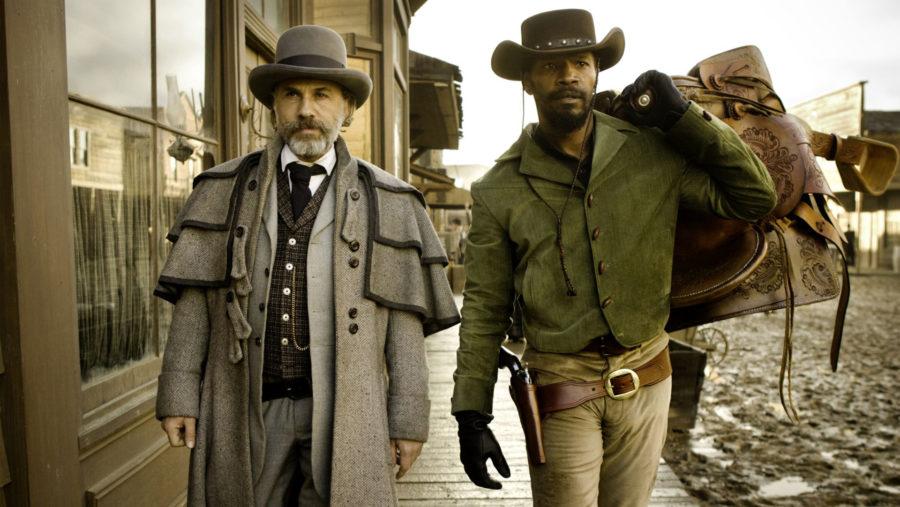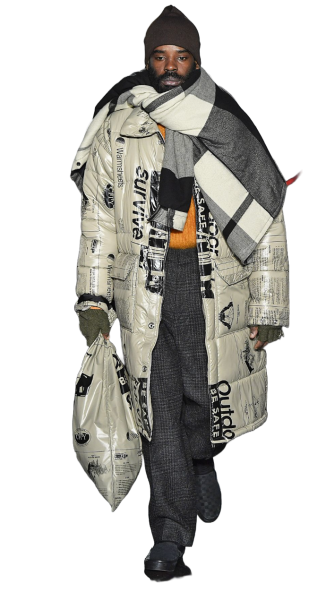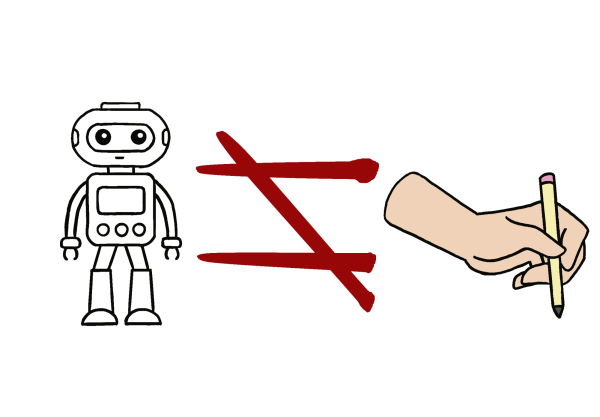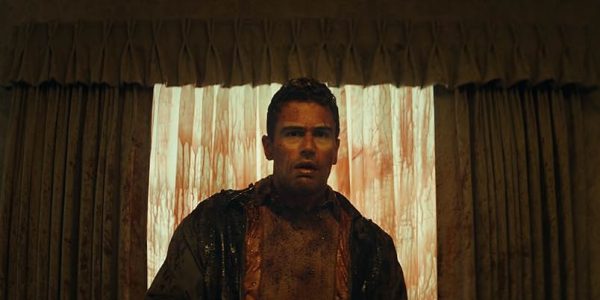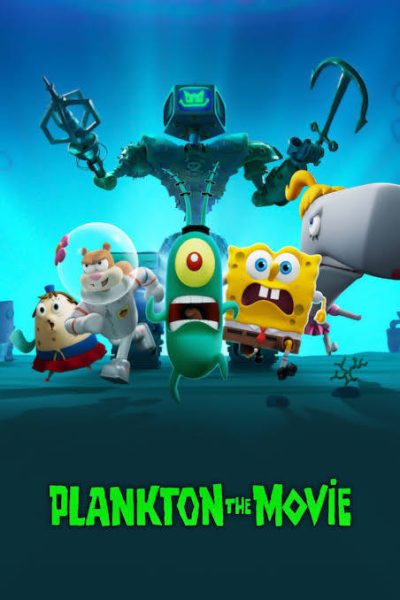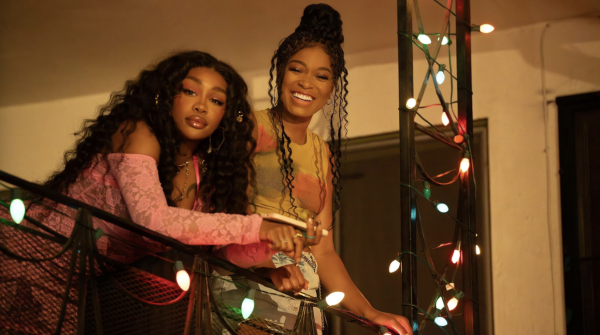The Reel: Quentin Tarantino- eight eras, one style
The model for historical and modern filmmaking
Christoph Waltz (left) and Jamie Foxx (right) in Quentin Tarantino’s “Django Unchained”, which was rated the #1 movie of 2012. (Image courtesy of the Weinstein Company)
So, you’ve clicked on this column. If you did, you probably know exactly who Quentin Tarantino is. Perhaps you don’t. Tarantino is a legendary writer and director, the creator of such masterpieces as “Pulp Fiction” (1994), “Django Unchained” (2012), the “Kill Bill” movies (2003 and 2004) and most recently, “The Hateful Eight” (2015). It’s likely that you saw one of these.
Let me first address the elephant in the room. Yes, I realize that Tarantino uses the n-word a lot in his films. He’s got a constant gleaming spotlight on him and a target on his back for doing it. Nevertheless, the word epitomizes the subject matter of his movies. In fact, Tarantino films wouldn’t be truly authentic or integral to society without an unrestrained film dialect. I wouldn’t find his films nearly as interesting if they didn’t poke at my expectations and create questioning thoughts in my head about the necessity of such language in a film that’s set in a modern atmosphere. Language is absolutely principal in such ballsy storytelling.
Tarantino started out small: he dropped out of high school and got a job ushering at a porn theatre in Torrance, Los Angeles. As an indie filmmaker, he starting out with his first feature, “Reservoir Dogs” (1992), starring Tim Roth and Michael Madsen, which received fantastic reviews from critics and screened at the Sundance Film Festival. He went on to write and direct “Pulp Fiction,” starring Samuel L. Jackson and John Travolta, “Jackie Brown,” a powerful jab at racial tensions, starring Pam Grier, Robert de Niro, and Jackson, “Kill Bill”, a revenge story resembling Akira Kurosawa’s “Seven Samurai” (1954) starring Uma Thurman, which was released in two parts: one in 2003 and another in 2004, “Death Proof” in (2007), starring Kurt Russell and Rosario Dawson, “Inglourious Basterds” (2009), my personal favorite Tarantino film, starring Brad Pitt, Christoph Waltz and Diane Kruger, “Django Unchained” (2012), his highest-grossing film starring Jamie Foxx, Waltz and Leonardo DiCaprio, and the latest, “The Hateful Eight” (2015) starring Jackson, Madsen, Roth, Channing Tatum, Russell and Jennifer Jason Leigh
So, it’s evident that every single film that he’s made received universal praise from critics. On Rotten Tomatoes, the lowest score a film written and directed by him is 75%, “The Hateful Eight”. Of course, this was a result of several things. First, the script was leaked and several things needed to be changed. Tarantino had to improvise with different scenes and actors/actresses, endings, and versions to be released to theatres (I managed to nab a ticket to a screening on the amazing 70mm film that he specifically picked for production) and home release. The theatre release was structured like a play, with an overture, intermission, and narration by Tarantino himself.
So the first part of this column has been a little history lesson, a story about a creative mind who keeps his films independent, not afraid to create art against controversy and the influence of large production companies. But what makes his films so good? Here’s where it gets a bit complicated. His films are honestly for everyone; those who enjoy romance, violence, politics, Western styles, modern styles, everything. Personally, what sells me is his writing- or more accurately, the dialogue in his films.
Whenever I watch a film, I base my judgement of it on dialogue. What does the spoken word say about each character? How does it move the plot forward without being cringeworthy? What is a scene’s purpose? Does it have one? For me, dialogue-heavy movies are the shit.
“But Tarantino’s films are particularly known for their violence or obscenity. Why choose dialogue?” you might ask. The reason why I particularly enjoy the caliber of Tarantino writing is because of its instrumental value in generating anxiety and furthering conflict. He foreshadows, establishes and jests. Because he’s completely fine with violence, there’s absolutely no certainty in the scenes that he placed on the screen. Let me show you:
I’ll discuss the opening scene from my favorite Tarantino film (and #3 on my all-time favorites list), “Inglourious Basterds”. So, there’s a Frenchman outside his house, on a grassy plain. A title card pops up- “Once upon a time in Nazi-occupied France…”. There’s the establishment: Nazi Germany is currently in control of France. A car pulls up with a high-ranking German officer (it’s evident based on the way he’s surrounded by bodyguards/soldiers and how he’s dressed), played by Christoph Waltz, who steps out and requests entry into the Frenchman’s home. The Frenchman, known as LaPadite, appears disdainful and fearful- right off the bat, we know that something is off. But it could just be the fact that an S.S. guard is on his property, right? Here, Tarantino jump starts the suspense, with the help of Ennio Morricone’s legendary combination of German and Western styles (the opening soundtrack is called “The Verdict,” I highly recommend that you listen to it), establishing a threat. The S.S. Officer, Hans Landa (in my opinion, the best villain in movie history), asks to be a guest in the Frenchman’s home, and soon reveals that he’s searching for a Jewish family of whom he suspects are being sheltered by LaPadite. LaPadite denies such claims, suggesting that the Jewish family that Landa is looking for escaped to Spain following the blitzkrieg.
But as the pair converse, the camera pans down, past LaPadite and Landa’s feet, under the floorboards, revealing five people: the Jewish family that Landa is searching for. In the next cut, the conversation flows between the Frenchman and Landa with no change in tone. But yes, there is a change in the tone. Not in the speaking, but in the dialogue. The audience’s viewpoint has changed from uncertainty to worry, which will eventually evolve into anxiety- will Landa discover the family? The conversation drags on and on, until Landa eventually says that everything is fine and that he’s going to leave. But he doesn’t. He continues talking, dragging the suspense from a painful amount of time. We begin to wonder if Landa is just playing with his food. At one point, he lights a cigar, taking lengthy pauses, which is a genius way of stretching tension to its furthest (This might be a choice on Waltz’s part; Tarantino cast the right guy).
The entire scene is filmed in one take, taking on a decidedly human element to the story. There’s no music, aside from the heavy thumping of the audience’s hearts. Eventually, Landa extorts a confession out of LaPadite, and an approximately fifteen-minute conversation of beautifully intricate dialogue ends in a burst of machine gun fire and the deaths of an entire family with the exception of the daughter- the survivor who will become a main character seeking revenge.
This way of establishing conflict is absolutely fantastic and a unique way to introduce two central characters who take charge with intent, resolve, and purpose. Legendary filmmaker Alfred Hitchcock once said, “There is no terror in the bang, only in the anticipation of it.” Imagine if Tarantino hadn’t introduced the family early on. Would the following dialogue be as effective?
A second feature of Tarantino dialogue is the style. Aside from well-crafted suspense, Tarantino’s writing encompasses a certain brutality to it, a true “tell-it-like-is” style that is affirmative and aggressive, most reflected in his Westerns. In his other films, the dialogue disregards the style embraced and instigates/establishes conflict. Each word holds a purpose, each sentence a message.
Tarantino is also a fan of nonlinear plotlines- meaning that he embraces flashbacks and multiple perspectives (example: “The Hateful Eight”), multiple simultaneous plot lines converging towards one epic finale (example: “Inglourious Basterds”), and varying story velocities (example: “Django Unchained”).
Tarantino is a legend in action sequences and a pioneer in cinematography. Perhaps one would like him because he makes Westerns that still contain the soul of the late 1900s, or because of his use of principle and satire to fabricate movies centered around anti-heroes or taboo elements. He’s announced that he will only make ten movies– which truly showcases the amount of work and thought he puts into his craft.
But what truly sells it for me is his dedication to his craft and creativity in storytelling. Hollywood needs more of that.



